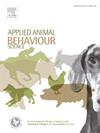Could restricting horses' REM sleep improve dressage performance?
IF 2
2区 农林科学
Q1 AGRICULTURE, DAIRY & ANIMAL SCIENCE
引用次数: 0
Abstract
The relationship between athletic performance and sleep deprivation is well-described in human medicine. Little is known about whether sleep deprivation affects the horses’ athletic performance. Previous studies show how changing environment, such as hospitals, can alter sleep patterns in horses, decreasing their total rapid eye movement (REM) during sleep time. Periods of REM sleep deprivation are frequently encountered in the management of athletic horses, particularly during transportation and temporary stabling at competitions. The objective of this study was to evaluate whether an association exists between athletic performance, welfare, and sleep deprivation in horses subject to potential REM sleep deprivation. The horses in this study were placed in a simulation of a competition setting, in which the horses did not laydown. A randomized crossover study simulating a competition outside from home was performed using ten dressage athletes Lusitano Pure Breed horses, aged 4–7 years, divided into two groups: sleep deprivation and control. All animals were observed in both conditions. REM sleep deprivation was accomplished by preventing horses from entering sternal or lateral recumbency for three consecutive days (72 h). The Horse Grimace Scale (HGS) was used in the morning and afternoon. Salivary cortisol was collected once daily at 10 a.m. Heart rate variability (HRV) was measured once daily for 7 min using a frequency meter. After 72 h, the horses participated in a voluntary approach test and a test competition, with scores from judges based on FEI young horses test competition and a questionnaire for riders. Sleep deprivation did not affect horses’ physical performance when comparing the judges’ scores. Judges’ scores in the dressage competition had weak reliability. The riders were not able to identify with accuracy sleep deprived animals; however, some riders described their horses with lower level of focus or tired when sleep deprived. HGS is a valuable tool in the measurement of acute pain in horses, but it is not sufficiently sensitive to identify REM sleep alteration. HRV and salivary cortisol concentration did not change in horses subjected to REM sleep deprivation. Irritability and reluctance in horses with sleep deprivation should be further investigated in larger groups. There were no marked alterations in the parameters evaluated regarding REM sleep interference in horses, and there was no notable change in test competition scores, indicating that short sleep pattern interference does not affect their athletic performance. However, sleep pattern interference may link to changes in their focus during exercise.
限制马的快速眼动睡眠能提高盛装舞步的表现吗?
运动表现和睡眠剥夺之间的关系在人类医学上有很好的描述。关于睡眠剥夺是否会影响马的运动表现,人们知之甚少。先前的研究表明,不断变化的环境,如医院,如何改变马的睡眠模式,减少它们在睡眠期间的快速眼动(REM)。快速眼动睡眠剥夺是经常遇到的管理运动马,特别是在运输和临时马厩的比赛。本研究的目的是评估在遭受潜在的快速眼动睡眠剥夺的马的运动表现、福利和睡眠剥夺之间是否存在关联。在这项研究中,马被放置在一个模拟比赛的环境中,在这个环境中,马没有躺下。采用10匹年龄4 ~ 7岁的卢西塔诺纯种马进行模拟室外比赛的随机交叉研究,将其分为两组:睡眠剥夺组和对照组。在两种条件下对所有动物进行观察。通过连续三天阻止马进入胸骨或侧卧位来实现快速眼动睡眠剥夺(72 h)。上午和下午分别采用马鬼脸量表(HGS)。每天10:00 采集唾液皮质醇1次。心率变异性(HRV)每天使用频率计测量一次,持续7 min。在72 h后,马匹参加了自愿接近测试和测试比赛,裁判根据FEI年轻马匹测试比赛和骑手问卷进行评分。在比较评委的分数时,睡眠剥夺并不影响马的身体表现。在盛装舞步比赛中,裁判评分的可靠性较弱。骑手们无法准确识别睡眠不足的动物;然而,一些骑手描述他们的马在睡眠不足时注意力较低或疲倦。HGS在测量马的急性疼痛方面是一个有价值的工具,但它在识别快速眼动睡眠改变方面不够敏感。被剥夺REM睡眠的马的HRV和唾液皮质醇浓度没有变化。睡眠剥夺的马的易怒和不情愿应该在更大的群体中进一步研究。马的快速眼动睡眠干扰评估参数无显著变化,竞赛测试成绩无显著变化,表明短睡眠模式干扰不影响马的运动表现。然而,睡眠模式的干扰可能与他们在运动时注意力的变化有关。
本文章由计算机程序翻译,如有差异,请以英文原文为准。
求助全文
约1分钟内获得全文
求助全文
来源期刊

Applied Animal Behaviour Science
农林科学-行为科学
CiteScore
4.40
自引率
21.70%
发文量
191
审稿时长
18.1 weeks
期刊介绍:
This journal publishes relevant information on the behaviour of domesticated and utilized animals.
Topics covered include:
-Behaviour of farm, zoo and laboratory animals in relation to animal management and welfare
-Behaviour of companion animals in relation to behavioural problems, for example, in relation to the training of dogs for different purposes, in relation to behavioural problems
-Studies of the behaviour of wild animals when these studies are relevant from an applied perspective, for example in relation to wildlife management, pest management or nature conservation
-Methodological studies within relevant fields
The principal subjects are farm, companion and laboratory animals, including, of course, poultry. The journal also deals with the following animal subjects:
-Those involved in any farming system, e.g. deer, rabbits and fur-bearing animals
-Those in ANY form of confinement, e.g. zoos, safari parks and other forms of display
-Feral animals, and any animal species which impinge on farming operations, e.g. as causes of loss or damage
-Species used for hunting, recreation etc. may also be considered as acceptable subjects in some instances
-Laboratory animals, if the material relates to their behavioural requirements
 求助内容:
求助内容: 应助结果提醒方式:
应助结果提醒方式:


